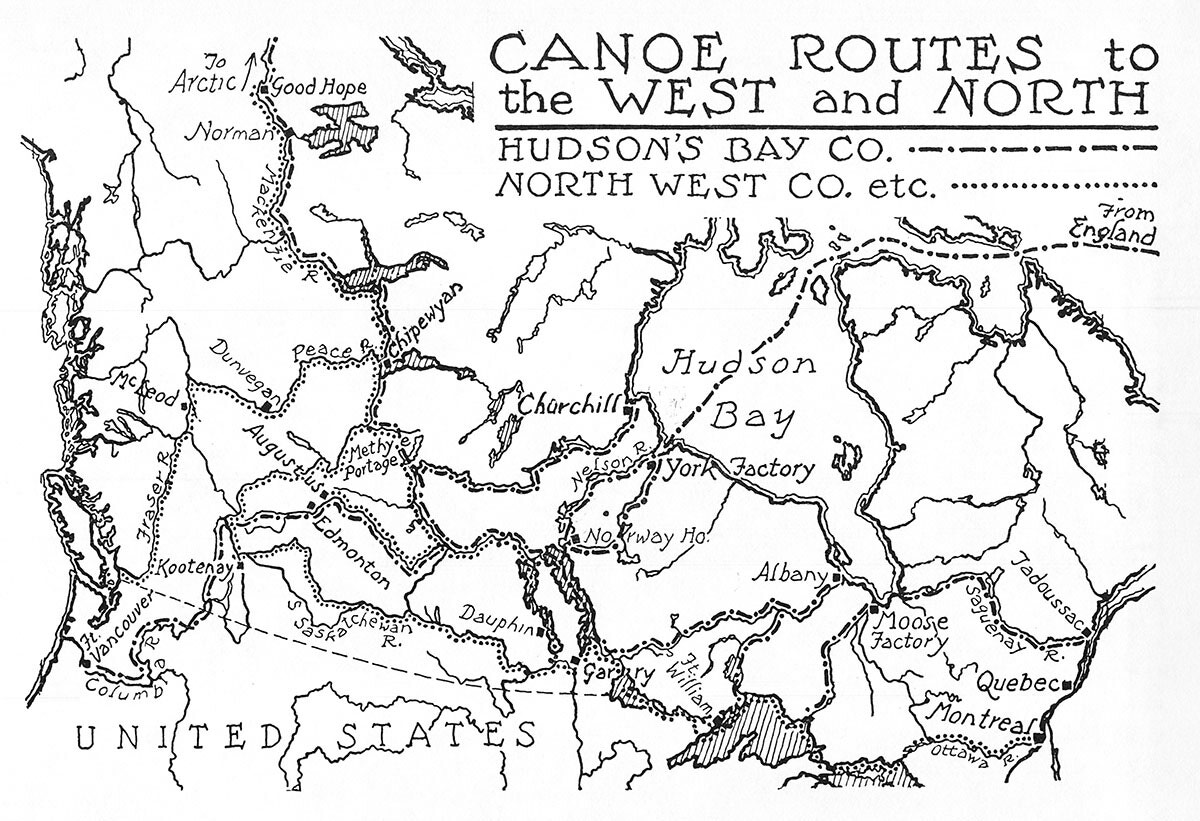Canoe Routes To The West And North
Library and Archives Canada, Acc. No. 1972-26-136
Remarks
C.W. Jefferys' notes about this picture from The Picture Gallery of Canadian History Volume 2
In the earliest years of British rule the merchants of Montreal began to engage in the fur trade and to equip expeditions to the north and west. The route usually followed was by the Ottawa River and the upper great lakes to Grand Portage, near the head of Lake Superior. After 1796, when this neighbourhood was included in the territory of the United States, Fort William, some miles to the east, became the meeting place of the canoes from Montreal and the fur-traders of the north-west interior. Here the trading goods were unloaded, and the packs of the season's furs taken on board the Montreal canoes for their return voyage.
These Montreal canoes were about 36 feet long and 6 feet wide at the middle, and carried from 3 to 4 tons. They were paddled by crews of 8 to 10 voyageurs, who were commonly called "Mangeurs du Lard," or "Pork Eaters," their provisions generally consisting of salt pork and hulled corn or peas. They travelled in "brigades," usually of 4 canoes, to facilitate the passage over the numerous portages on the route. These large canoes were pushed up the steepest places, cushioned on ever- green boughs, or were carried by 6 men, bottom side up. They left Lachine in May, reaching the meeting place early in July. The trading goods consisted of coarse woollen cloths, blankets, ammunition, twist and carrot tobacco, thread, lines, twine, hardware, cutlery, brass, copper, and iron kettles, silk and cotton handkerchiefs, shoes, nets and fish hooks, spirituous liquors, colours, vermilion especially, beads, silver ornaments, etc.
Meanwhile, the furs gathered in the far north and west were being carried by toboggans and canoes, so as to reach the Lake Superior meeting place by the time of the arrival of the goods from Montreal. For a month or more the portage over the height of land separating the great lakes waterways from those of the northern interior was a busy place, as lines of men laden with packs of furs, or barrels, sacks and bundles of trading goods hurried along the trail to the waiting canoes.
The northern canoes were about half the size of those from Montreal: about 25 feet long by 4 feet wide, with a crew of 4 to 6 men. In portaging they were carried by 2 men at bow and 2 at stern, bottom side down.
In addition to these, there were also light express canoes, used for the speedy transportation of correspondence, news, and passengers, such as officials and partners of the trading companies. These carried no freight beyond the provisions and baggage of the crew and passengers. They were paddled by a crew of 15 men, specially picked and paid extra wages for a speedy voyage. Dr. Bigsby says that the passengers sat on their rolled-up beds amidships, while the crew squatted in two rows on their bags of provisions, paddling 50 strokes to the minute to voyageur songs so timed, and stopping occasionally for a short spell to rest and smoke.
Much information and numerous pictures are to be found in various numbers of The Beaver, the Hudson's Bay Company's quarterly. Schoolcrafts' Indian Tribes gives details of the Indian methods of canoe building, and there are scattered references in J. J. Bigsby's The Shoe and Canoe, and in the numerous volumes of the Champlain Society publications dealing with the fur-trade and northern exploration.
Published References
- Jefferys, Charles W. (1945) The Picture Gallery of Canadian History Volume 2, p.111




Comments